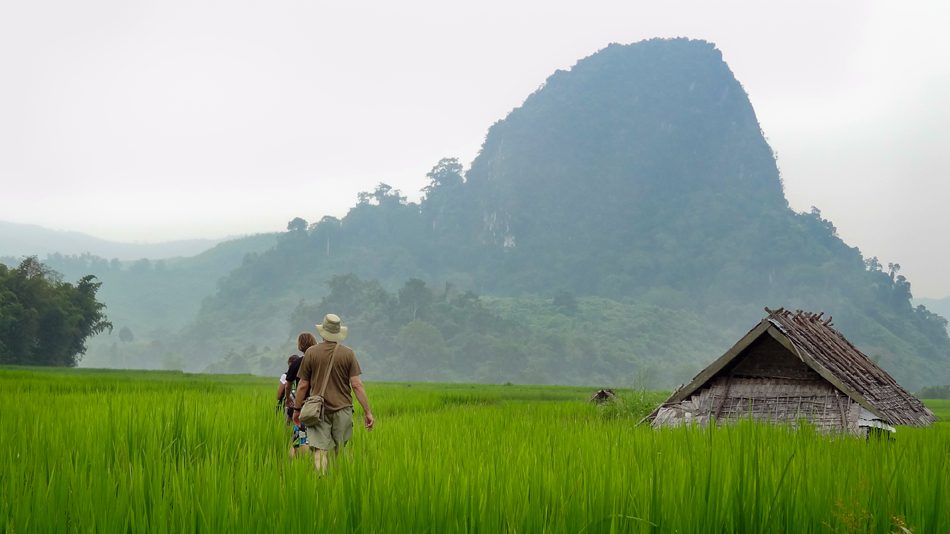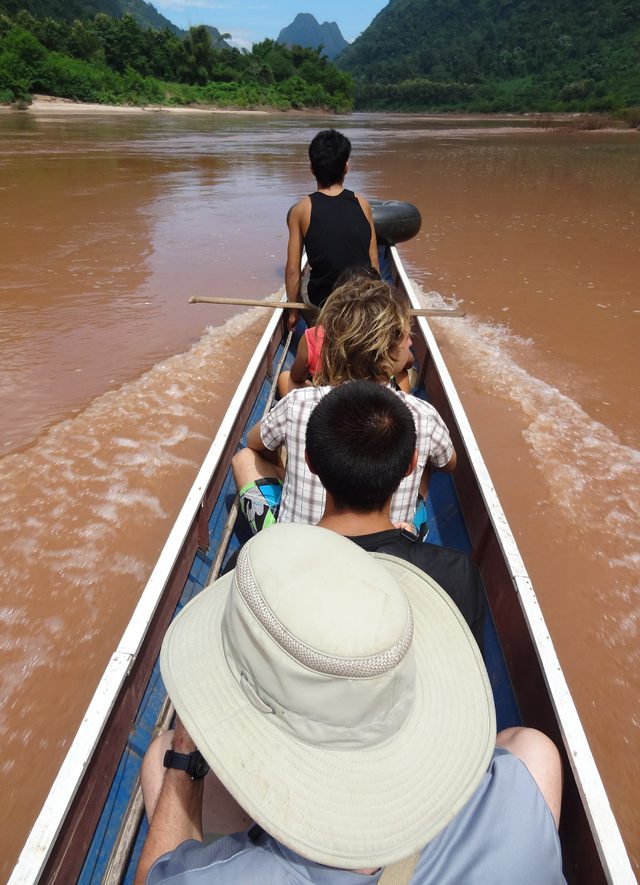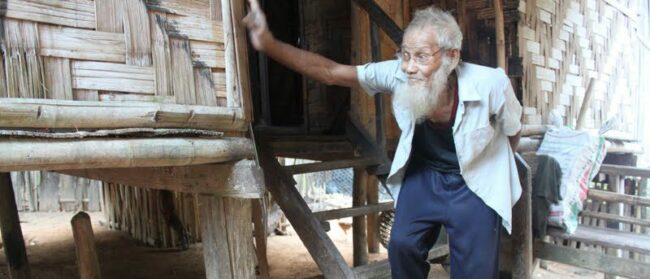From the Ho Chi Minh Trail to the edge of the tourist trail in northern Laos
By Matthew Crompton
The cave smells of limestone, wet hard-packed earth and cold water as we swim through the darkness. With one hand held above the water, my flashlight cuts an LED-white fan against the low ceiling of the cavern. Water drips down, musical in its echo. As the chamber opens up, we climb a mud-slick slope into an expansive hall of crags and stalactites, passages running down like rabbit warrens deep into the earth from its edges, our shadows swallowed by the deeper darkness like ghosts of a past not quite vanished.

“My wife was born here in the cave in 1968,” says Dr Joy Saysananong back in the riverside hamlet of Muang Ngoi – pronounced ‘Mong Noy’ and also known as Muang Ngoi Neua. “For four years, 1968 to 1972, everyone here living in the cave could not stay in the town. Everyday, 6am, airplanes come – Bomb! Bomb! Bomb! Bomb! Bomb! – then 6pm every day, airplanes come again – Bomb! Bomb! Bomb! – and people run back to the cave.”
It was partly the geology of this isolated region of northern Laos, with its dramatic karst-limestone peaks and caverns, that saved its people during the CIA’s so-called ‘Secret War’. The United States military, attempting to interdict war supplies travelling along the Ho Chi Minh Trail into Vietnam, flew up to 500 sorties a day over the country, dropping as many as 390,000 tonnes of bombs a year (more than was dropped on Germany or Japan during WWII) into one of the poorest nations in the world.
Today, these very same karst formations serve not as a refuge, but as a symbol of Muang Ngoi’s newfound prosperity, drawing a modest but steady stream of visitors up the muddy Nam Ou river from the nearest road, to enjoy what may be Laos at its elemental best: a place with neither cars nor internet nor electricity – save that supplied from six to ten each night by generators.
Drifting up in a longboat to the riverbank in the dusty orange late-day light, Muang Ngoi at first seems like a kind of pastoral idyll – ducks waddling down the town’s single dirt lane past bamboo bungalows and gardens lush with banana and papaya trees and candy-pink hibiscus. And though reminders of its violent history are never far away, they are often tempered with a striking sense of grace.
Such is immediately apparent on the three-hour walk to the nearby village of Huay Bo, following a mud path across clear streams and through the emerald lushness of the rice fields. Along the path are bomb craters, transformed by rain and time into fishponds. The rusted casings of unexploded ordnance stand repurposed as decorations for village houses or used as berms for irrigation ditches. An old man approaches up the path, his right arm missing at the elbow, but a smile on his face.
Asked how the people of Muang Ngoi bore these depredations so stoically, Dr Joy merely shrugs. “First Japan come during World War Two. Japan go out, then France come in. When France go, the Americans come.” He lights a cigarette and exhales, searching for a word. “Is all just, you know, boh pen yang.”
That he should use this common Lao phrase – heard a dozen times a day to express everything from “You’re welcome” to “Don’t worry about it” – to absolve a generation’s worth of meaningless brutality, was at the heart of what made Muang Ngoi special. While boh pen yang means, “You’re welcome”, it also means, more broadly, “It is forgiven”, or even, “Life goes on”.

Plain sailing: a longboat ferries visitors up the reddish waters of the Nam ou river for a spot of tubbing
It is that spirit – part Buddhist forbearance and part languid laissez-faire – that permeates everything in Muang Ngoi. The days when the town served as a hideout for foreign opium enthusiasts are thankfully long over, but as night falls and the town’s few guests gather at Riverfront Bungalows on the high deck overlooking the Nam Ou, it’s easy to see what encourages visitors to come here: long, lethargic, congenial evenings and strong cocktails of Lao whisky, the sky pale lavender and boats drifting quietly on the indigo river below in the gathering dark.
In the morning, keen to get back out on the water, we take a longboat upriver and board a suite of battered inner tubes, drifting the six long kilometres back to town. The muddy, swirling current of the Nam Ou is reddish with runoff from the Lao clay soils and bounded by high walls of jungly karst, the lush Jurassic stillness broken only by the far-off putter of an outboard motor and snow-white birds lifting in elastic V’s before the deep green of the hills.
Floating slowly through, one sees a place that could so easily be called a wilderness, with a beauty more natural than human, were not the people living here – gracious and open-hearted, patient and resilient – among the finest of what being human is. In the quiet beneath the limestone cliffs and crags, the serpentine river flowing slowly back toward the easy hospitality of the town, one is reminded of all the very best of travel: a landscape not only unexpected, but unknown; one which powerfully compels the visitor to linger. This tiny corner of northern Laos seems exactly that rare place – one that has known by turns the trespass of foreign armies and tourists alike, and yet defines itself by neither.
There are challenges to this steadfastness. On the four-hour ride upriver to the market town of Muang Khua, where the road leads onward into Vietnam, there are bridge pylons and ribbons of macadam creeping gradually south down the Nam Ou like a cannon fuse – a guarantee that when at last these touch the town, it will be, as places always are, inevitably changed. As easy as it is to mourn this, there remains a sense of hope that this remarkable village can keep its heart, as much in plenty as it has in ruin; that it can weather backpackers just as well as bombs; and that when the buses and the tourists finally arrive, the people of Muang Ngoi will have just as much to teach their visitors as they will have to learn from them.

